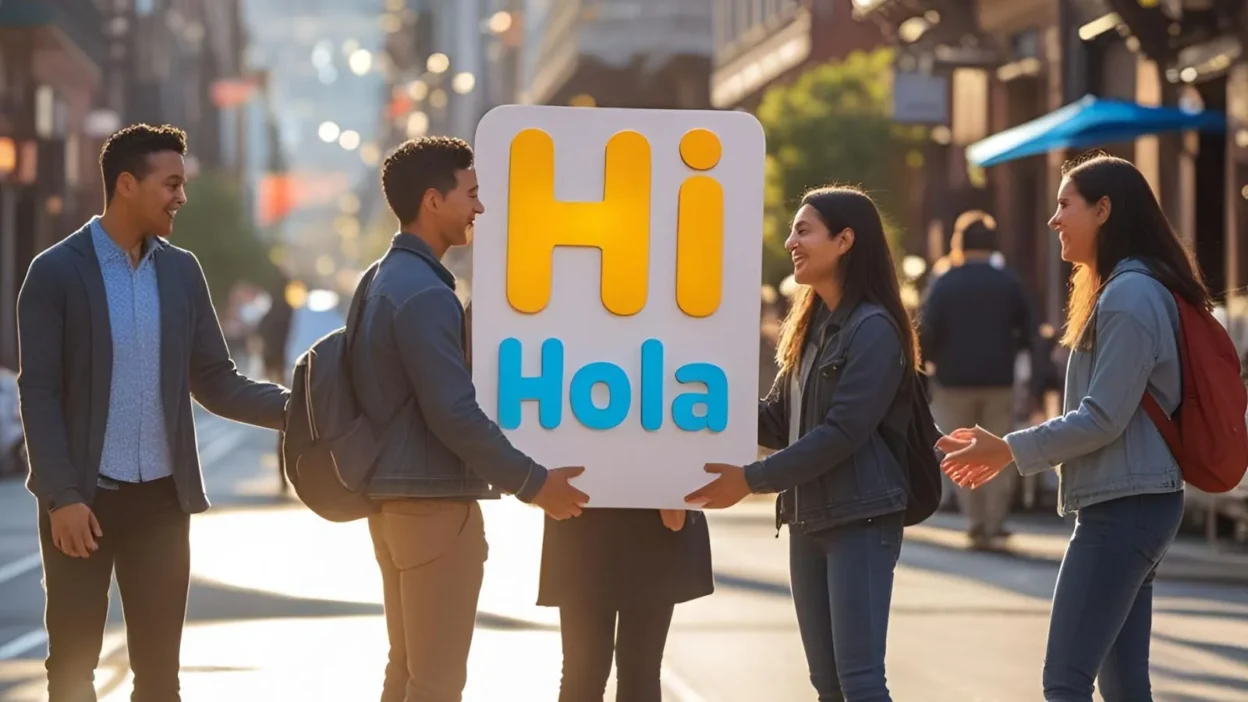Learning how to say hi in Spanish is one of the easiest and most useful ways to start speaking the language. Whether you’re traveling to a Spanish-speaking country, meeting new people, or just brushing up on your language skills, greeting someone properly sets the tone for a friendly interaction. From the casual “Hola” to more region-specific hellos, Spanish offers a variety of ways to say hi depending on the context.
In this guide, we’ll explore different greetings so you can confidently say hello in any Spanish-speaking situation.
Mastering these simple greetings is a great first step toward deeper conversations. Plus, showing effort in someone’s native language always leaves a positive impression.
1. Hola – Hello
Origin:
“Hola” is the most basic and universal Spanish greeting. It comes from Old Spanish and may be linked to the interjection hala, which expressed surprise or encouraged action.
Example:
👤 User A: Hola, ¿cómo estás?
👤 User B: ¡Hola! Muy bien, ¿y tú?
Use: Universal and friendly — works everywhere, with anyone.
2. Buenos días – Good morning

Origin:
This formal greeting literally means “good days,” and has been used in Spanish since the 14th century to wish someone a pleasant start to the day.
Example:
👤 User A: Buenos días, señora Gómez.
👤 User B: Buenos días, Carlos. ¿Todo bien?
Use: Formal and polite; used in the morning hours.
3. Buenas tardes – Good afternoon
Origin:
Used after midday, “Buenas tardes” is another time-sensitive greeting. “Tardes” means afternoons or evenings.
Example:
👤 User A: Buenas tardes, ¿ya comiste?
👤 User B: Buenas tardes, sí, hace un rato.
Use: Formal or casual, after noon and before dusk.
4. Buenas noches – Good evening / Good night
Origin:
“Buenas noches” can mean both hello and goodbye at night. In many Spanish-speaking countries, it’s used around or after sunset.
Example:
👤 User A: Buenas noches, ¿vienes a la fiesta?
👤 User B: ¡Claro! ¿Ya empezó?
Use: Formal or friendly; for nighttime greetings.
5. ¿Qué tal? – How’s it going?
Origin:
This informal greeting translates to “How’s it going?” and is common in Spain. “Tal” originally referred to conditions or status.
Example:
👤 User A: ¡Hola! ¿Qué tal?
👤 User B: Todo bien, ¿y tú?
Use: Informal, used among peers or friends.
6. ¿Cómo estás? – How are you?

Origin:
A standard follow-up to greetings like “Hola,” it’s used to ask about someone’s well-being.
Example:
👤 User A: ¡Hola! ¿Cómo estás?
👤 User B: Muy bien, gracias. ¿Y tú?
Use: Friendly and polite; works in most contexts.
7. ¿Qué hay? – What’s up? / What’s new?
Origin:
This greeting literally means “What’s there?” and is the equivalent of “What’s new?” in informal conversations.
Example:
👤 User A: ¿Qué hay, amigo?
👤 User B: Nada nuevo, todo tranquilo.
Use: Casual, modern, and relaxed.
8. ¿Qué pasa? – What’s happening?
Origin:
“Pasa” comes from the verb pasar (to happen/pass). It’s widely used across Latin America.
Example:
👤 User A: ¿Qué pasa, Juan?
👤 User B: Aquí nomás, descansando.
Use: Informal and friendly.
9. ¿Qué onda? – What’s up? (Mexico)
Origin:
A distinctly Mexican greeting, onda means “vibe” or “wave.” So you’re literally asking, “What’s the vibe?”
Example:
👤 User A: ¡Qué onda, güey!
👤 User B: Todo chido, ¿y tú?
Use: Informal, youth slang, especially in Mexico.
10. ¿Qué más? – What else? (Colombia, Venezuel
Origin:
Used primarily in Colombia and Venezuela, it’s like saying “What’s new?” or “What else is going on?”
Example:
👤 User A: ¡Hola! ¿Qué más?
👤 User B: Bien, trabajando. ¿Y tú?
Use: Friendly, regional slang.
11. ¡Ey! – Hey!

Origin:
Borrowed from English, “Ey” has become common in casual speech among Spanish-speaking youth.
Example:
👤 User A: ¡Ey! ¿Dónde estabas?
👤 User B: ¡Ey! Fui a comprar algo.
Use: Informal, friendly, modern.
12. ¡Hola, hola! – Hello, hello!
Origin:
A fun and enthusiastic repetition used to show excitement or affection.
Example:
👤 User A: ¡Hola, hola! ¡Qué gusto verte!
👤 User B: ¡Igualmente!
Use: Playful and expressive.
13. ¡Buenas! – Short version of “Buenas tardes/noches”
Origin:
A casual shortening used across Spain and Latin America. It skips the “tardes” or “noches” part but keeps the polite tone.
Example:
👤 User A: ¡Buenas! ¿Tienen mesa para dos?
👤 User B: ¡Sí, claro! Pasen adelante.
Use: Semi-formal and versatile.
14. ¡Quiúbole! / ¡Quiubo! – What’s up? (Mexico/Central America)
Origin:
Contraction of “¿Qué hubo?” meaning “What happened?” Popular in Mexico and parts of Central America.
Example:
👤 User A: ¡Quiúbole, compa!
👤 User B: ¡Quiubo! ¿Todo bien?
Use: Informal, friendly, region-specific.
15. ¡Aló! – Hello? (On the phone)
Origin:
Borrowed from the French “Allô,” it’s the standard phone greeting in many Latin American countries.
Example:
👤 User A: ¡Aló! ¿Quién habla?
👤 User B: ¡Soy yo, Ana!
Use: Used only when answering the phone.
Conclusion:
Spanish is full of expressive, regional, and colorful greetings that go far beyond just “Hola.” Learning the right way to say “hi” can help you build rapport, sound more natural, and even make native speakers smile.
¡Ahora te toca a ti! Which greeting will you try first?



